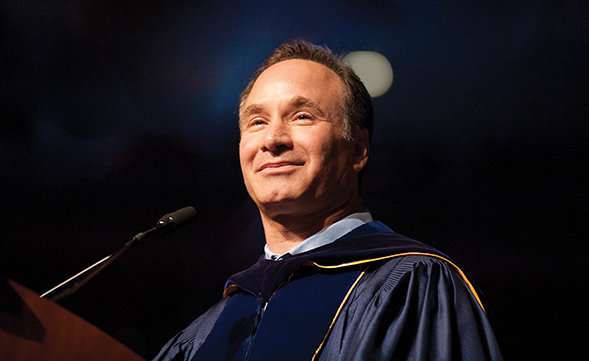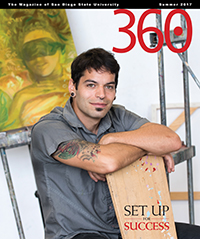Man with a Plan
During six years as president, Elliot Hirshman raised the aspirations of the SDSU community and elevated the university's national profile.

“Elliot is not satisfied with small ambitions.”
This story appears in the summer 2017 issue of 360: The Magazine of San Diego State University.
In his book, “Hail Montezuma,” an account of San Diego State University’s 100-plus-year history, anthropologist Seth Mallios chose a descriptor for each of SDSU’s first seven presidents. Samuel Black is the founder; Edward Hardy, the expansionist; Walter Hepner, the builder; Malcolm Love, the people’s president; Brage Golding, the short-timer; Thomas Day, the visionary; and Stephen Weber, the uniter.
Mallios, an SDSU professor, published his book in 2012, just a year after the university’s eighth president, Elliot Hirshman, took office and far too early for the SDSU community to evaluate his leadership. But if a second edition were ever published, outlining all this president has accomplished, Hirshman might be described as the game-changer.
In six years at the helm, Hirshman led SDSU to financial stability; strengthened faculty and staff commitment to student success; did some heavy lifting in the campaign that raised $800 million in private philanthropy; guided the progress of a strategic plan, “Building on Excellence,” that crystallized the university’s mission; and reshaped the physical landscape to showcase SDSU as an institution advancing on many fronts, including research and innovation.

As Elliot and Jeri Hirshman leave San Diego for Maryland, where he will take on the presidency of Stevenson University, faculty, staff, donors and colleagues said Hirshman’s ability to think conceptually and act with laser focus changed the course of SDSU’s future.
“Elliot is not satisfied with small ambitions,” said Mary Ruth Carleton, vice president for University Relations and Development. “He had a vision that helped us hone who we are and a spirit that pushed us to be the best we can be.”
More than lip service
During year one of his tenure, Hirshman met with thousands of faculty, staff, students, alumni and friends of the university. It was an early sign of his belief in shared governance, a philosophy he “lives and breathes,” said Marcie Bober-Michel, chair of the University Senate. The veteran professor said shared governance is more lip service than reality on many campuses, but Hirshman “genuinely appreciates the faculty and wants to know what they think.” His commitment to fund the hiring of 300 new tenure-track faculty members energized the campus after years of belt-tightening.
“The actual number hired may not be as significant as the vision it represents,” Bober-Michel said. “Elliot led the reinvention of this university by steering the colleges toward hiring young faculty in emerging research areas.”
Many faculty members consider this his greatest legacy. During Hirshman’s six years, SDSU moved up 37 spots in the U.S. News and World Report ranking of national universities—from No. 183 to No. 146—and also reached No. 74 among public research universities. But more significantly, Hirshman leaves behind a team with heightened research aspirations and an increasingly successful record of winning research grants, said Sam Kassegne, a professor in the College of Engineering.
“From the beginning, he made commitments to our research mission, and he kept them,” Kassegne asserted. “He understood that in order for us to be a 21st century institution, we need 21st century facilities. The Engineering and Interdisciplinary Sciences (EIS) Complex, which will open next year, is a clear indication of our ambitions.”
Hirshman developed a funding model for the EIS Complex involving private, state and university support. Then he worked with the university’s fundraising team to secure major gifts. William Leonhard, ’64, is one of 22 donors whose philanthropy has named centers, conference rooms and other spaces within the EIS Complex (story on page 24).
“He puts donors at ease, but he also gets you to understand that making a gift is important to the university,” Leonhard said. “Years ago, he invited me to breakfast, and I ended the meal pledging $1 million. It was all very low-key, no pressure.” Leonhard laughed. “Now I tell him: no more breakfast invitations.”
Great partnership
Hirshman became president as SDSU publicly launched its first comprehensive campaign in 2011. Neither he nor his wife, Jeri, had extensive fundraising experience, but they met with donors frequently to press SDSU’s case for support, Carleton recalled.
“They have a great partnership,” she said, “and they knew it was important for both to be involved in the business of the university.”
Hirshman’s determination to forge stronger alliances with the San Diego community took shape in several initiatives, including Price Community Scholars. He approached the Price Philanthropies Foundation with a proposal to provide financial support to incoming freshmen from the economically disadvantaged City Heights area.
Each Price Community Scholar is matched with three City Heights middle school students in long-term mentoring relationships that teach the younger students about high school graduation requirements, SAT testing, financial aid and other college-prep topics. Many of the middle schoolers later become the first in their families to attend college.
“The results are demonstrable and compelling,” observed Price Philanthropies President Robert Price. “San Diego State has always been an important part of this community, but the level of scholarship has advanced under Elliot Hirshman. He is responsive, dependable and engaging. There’s a certain lightness about him that makes people feel comfortable.”
Connection points
Members of the President’s Cabinet said he set high expectations for senior administrators, and challenged them to identify potential seismic shifts in their divisions. Eric Rivera, vice president for Student Affairs, recalled an early conversation with Hirshman that literally transformed the lives of many commuter students.
The university’s year-to-year increases in graduation rates had been a point of pride since the early 2000s, but Hirshman dug deeper into those numbers. “Tell me who’s not graduating,” he asked Rivera.
“Elliot picked up on the achievement gap between commuter and residential students. He understood the need for a connection point on campus for every student,” Rivera said.
As a result, SDSU opened a Commuter Resource Center and created peer mentoring programs, learning communities and support staff positions dedicated to commuter student success. In just three years, the graduation rate for commuter students rose by 10 percentage points—from 58 to 68 percent.
“He wanted to understand the student experience,” explained Andrea Dooley, Hirshman’s first chief of staff and now an assistant vice president for Student Affairs. “If something wasn’t right, he wanted to fix it. Ultimately, he cares deeply about our students, and they have flourished under his leadership.”
Humanity and wisdom
Hirshman came to SDSU during a period when his own children were college students, a factor that profoundly influenced his outlook, Rivera said. Keith Behner, ’71, a donor who became friendly with the Hirshmans, recalled an occurrence that illustrates the parent within the president.
“We were attending a football game and the Aztec quarterback was having a rough time,” Behner said. “When the crowd started to boo, Elliot was genuinely distressed. ‘That kid is doing the best he can,’ Elliot said. ‘Don’t they realize he is somebody’s son?’”
Hirshman’s humanity—and his wisdom—are apparent to those who know him well, said Mildred Garcia, president of California State University Fullerton. His vision has shaped the future of the CSU system and created a campus of excellence in San Diego that supports high achieving students from all environments.
“Elliot’s deep commitment to issues of social justice and equity is reflected in San Diego State’s record as a top university for recruiting and retaining underserved students,” Garcia said. “As a woman of color, it is wonderful to see someone who represents the majority speak up for these young people.”
There has been no shortage of tributes to the Hirshmans during the last few months. Alumni Susan, ’89, and Scott Salka, '87, honored their tenure with an endowed gift to the School of Nursing, noting that Jeri spent two decades as a nurse before retiring to become first lady of SDSU.
“The impact made by Elliot and Jeri Hirshman at SDSU and in the San Diego community sets us up for a stronger and more successful future,” Susan explained. “Honoring them with an endowment seemed like a great way to thank them and to keep a part of them here with their SDSU family.”
The Hirshmans are also leaving a legacy in the form of an endowment supporting academic initiatives and student scholarships—both game-changers for the next generation of Aztecs.



